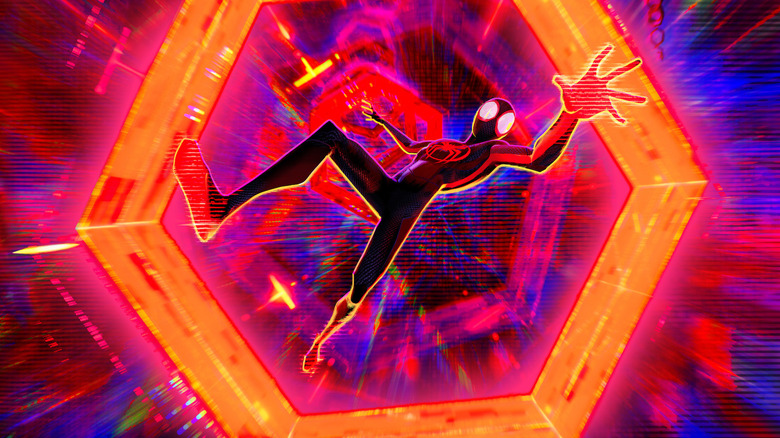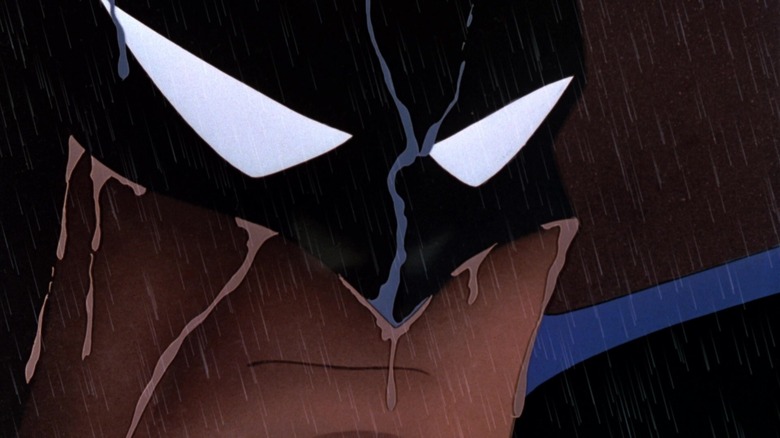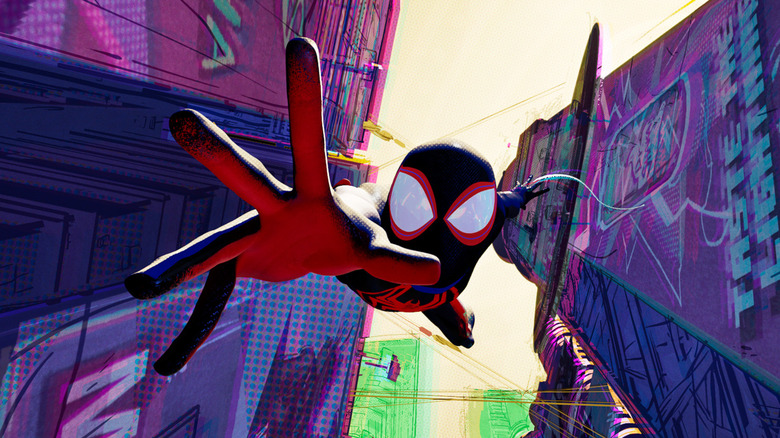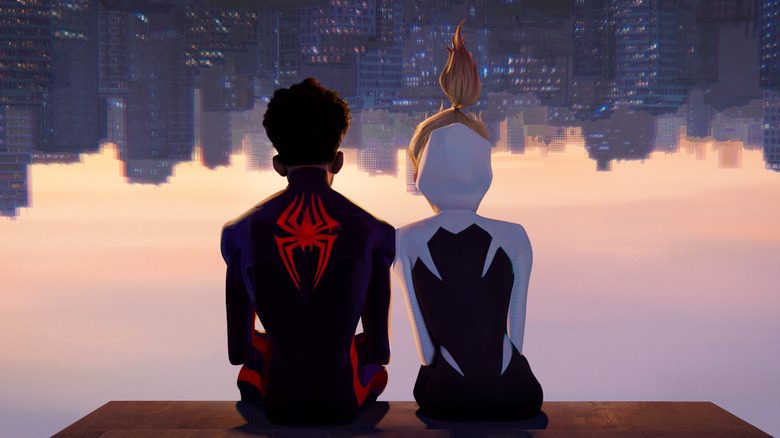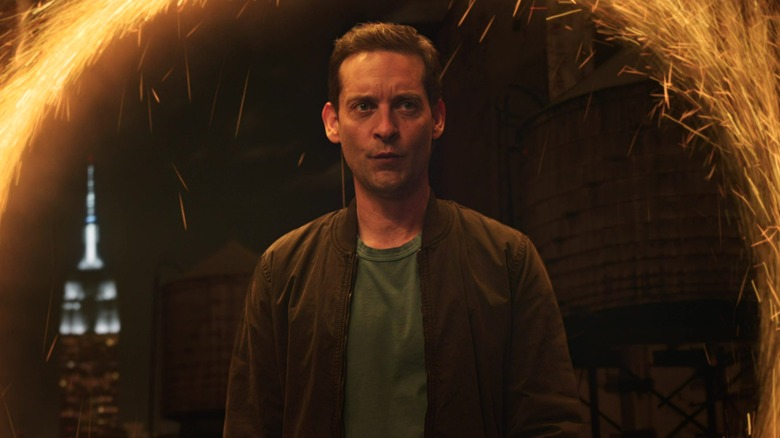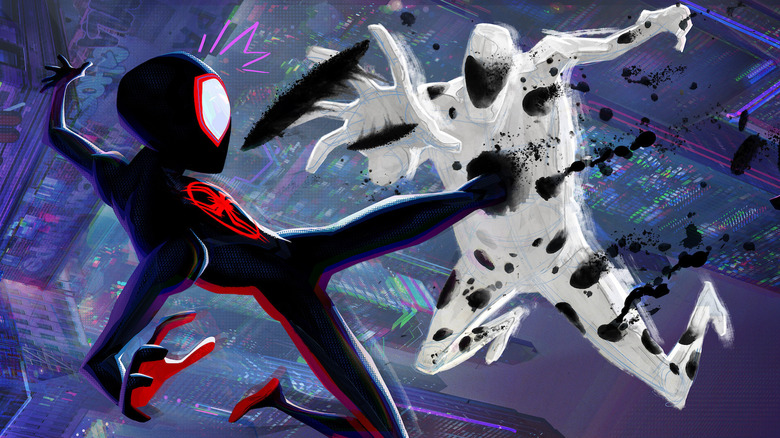The Spider-Verse Movies Are So Far Ahead Of Other Superhero Movies That It's Embarrassing For Everyone Else
This post contains spoilers for "Spider-Man: Across the Spider-Verse."
I don't write much about superhero films. You can probably count my superhero-related pieces on two hands, maybe even one. Despite being the cinematic cultural dominator of the 21st century, every passing year brings me further and further away from the genre. 15 years ago, with the release of "The Dark Knight" and the beginning of the Marvel Cinematic Universe with "Iron Man," I couldn't be more excited to head to the theater opening night. Now when I see a superhero film on the calendar, it's an obligation.
What makes it all the more dispiriting is that I really do like superheroes. Every Wednesday I head over to my local comic book shop and grab my pull list made up mostly of superhero comics. I eagerly anticipate the latest "Nightwing" by Tom Taylor and "Betsy Braddock: Captain Britain" by Tini Howard. In fact, the further I drift away from superhero cinema, the closer I come to their source material.
That isn't to say there haven't been superhero films from the last 15 years that I enjoyed. I really like James Gunn's "Guardians of the Galaxy" trilogy and was delighted by the earnest maximalism of James Wan's "Aquaman." I even enjoyed the two "Venom" films. But the hits are few and far between, and the ones I like still wouldn't rank among my favorite films of all time — or even the last decade. That is ... except for two films: "Spider-Man: Into the Spider-Verse" and its newly released sequel "Across the Spider-Verse." In the endless sea of mediocre superhero films I wade through year after year, these two gems from Sony Pictures Animation are the beacons guiding me to safe harbor, reminding me why I love superheroes in the first place.
Superheroes should be drawn
Perhaps more than anything else, the reason so many superhero films fall flat in my eyes comes from their distinct lack of visual flair. No two comic books look alike. Each artist who puts a pencil to paper has their own style. And yet, almost none of these movies feature even a single frame that dazzles me as much as your ordinary issue of a comic book, especially in the MCU. They want to exist in what is ostensibly the real world and abide by what they deem "realistic," which usually just amounts to making everything look like concrete sludge and having everyone stand in front of a green screen to maybe add in something interesting to look at later. Meanwhile, the actual coverage of a scene is purely functional, featuring loads of shot-reverse-shot dialogue scenes and flat, uninspired wide shots.
Placing these characters in animation, you aren't bound by the physical and logistical limitations of a live-action production. Take what is roundly regarded as the pinnacle of superhero storytelling not on the comic page: "Batman: The Animated Series." In order to best imagine the world of Gotham, the production decided to have the artists use black paper for their drawings rather than the standard white in order to best produce shadows, mood, and contrast. Consequently, it looked like no other cartoon before it.
The "Spider-Verse" films take this to a whole new level, even mixing art styles within one image. The filmmakers use character and emotion to dictate what the frame will look like. In "Across the Spider-Verse," there are shot-reverse-shot scenes where every cut radically changes the color palette and backgrounds, shifting to the scene's mood. No other movie looks like them, and in a landscape of conformity, the boldness of the "Spider-Verse" is a welcome respite.
The dynamism of comic book action
Nowhere are my visual complaints more evident than in the big action set pieces that generally get people to see these things on the big screen. They are either overly edited, hastily choreographed, gloopy CGI-filled messes or so lifeless that you'd rather be watching the second hand on your watch go around in circles. The prime example of this is the airport showdown in "Captain America: Civil War," which should be this thrilling hero vs. hero battle that is mainly just people in black and gray suits running around a black and gray background. Even with all of the visual effects and virtual cameras, these filmmakers rarely find inventive ways of moving that camera or framing their heroes.
For a superhero like Spider-Man, animation could not be a better fit for how the character operates in action. The web-slinger is in constant motion, thwipping around every which way you can imagine. More so than almost any other superhero, you can describe Spider-Man as "acrobatic" or "balletic," and having endless possibilities of how to render that character in space allows you to take full advantage of that. Animation also allows you to cheat physics, speed, and space in a way the boundaries of reality can't, making the superheroic feats even more super.
The "Spider-Verse" filmmakers also understand how we process action on the comic page and bring that into a 3D space. If there's a quick frame that is packed with characters and action, it will almost always be legible because the action will either be centered or read from left to right, like a panel. The "Spider-Verse" films are much faster than their live-action counterparts, yet those are always more disorienting because there's no intention in framing. Action should be exciting, not time-killing.
Unafraid of quiet character moments
With all the whizz-bang multiversal shenanigans of "Spider-Man: Across the Spider-Verse," my two favorite scenes of the film are its two quietest. The first comes when Gwen Stacy (Hailee Steinfeld) makes her way to Miles Morales' (Shameik Moore) universe, and the two share a heart-to-heart while sitting upside-down at the top of the Williamsburg Bank Tower, expressing how each one feels so isolated from their own existences and only can find kinship in each other's experiences. The other also occurs on a rooftop, where Miles' mother Rio (Luna Lauren Vélez) sees how much her son is struggling to open up to her about whatever tempest swirls around in his head.
Whenever most superhero movies try to be emotional, they go one of two ways. They either are histrionic or resort to cliched pablum. Rarely are characters given the opportunity to just sit, take a breath, and be in the moment with how they're feeling. But these are the moments where we truly get to know and care about these characters and want to see them overcome whatever obstacles are in their way. A quiet hug between Gwen Stacy and her father, as the colors shift from a green-blue to an orange, says so much without saying anything.
These scenes require a tremendous amount of confidence from the filmmakers that they understand these characters and trust the audience will understand them too. The "Spider-Verse" films are also PG-rated movies, aimed at even a slightly younger audience than the typical superhero film, and having that kind of trust in your young audience isn't always a forgone conclusion, even when it should be. I know the temptation in a superhero film is to have constant drama, constant thrills, and constant movement, but if that's all you have, you'll just exhaust your audience.
Easter eggs and references that aren't annoying
I know so many of y'all had a blast with "Spider-Man: No Way Home." I've seen the videos of people hooting and, indeed, hollering in the theater when Andrew Garfield and Tobey Maguire enter the movie. For me, I found everything about it hollow. All I could see here was cheap exploitation, glomming onto people's memories of their younger years in order to manufacture an inauthentic giddy response based purely on nostalgia. Superhero movies have become increasingly self-referential, but that usually just amounts to patting themselves on the back. All of the time travel stuff in "Avengers: Endgame" made me feel the same way.
Both "Spider-Verse" movies are filled with references. We even see brief glimpses of both Garfield and Maguire in "Across the Spider-Verse," along with shoutouts to videogames, cartoons, past comic book eras of Spider-Man, Donald Glover as a live-action Prowler, and, most surprisingly, Phil Lord and Christopher Miller's "The LEGO Movie." The difference between how other superhero films do it and the "Spider-Verse" pictures is that the references are never the point. They are good for a gag or a visualization of a concept, but we never dwell on a reference for more than a couple of seconds. The weight of the story always rests on the characters the film is following discovering new things.
"Across the Spider-Verse" goes so far as to be about breaking apart why we need to be constantly self-reflexive and cyclical about our superhero stories. They understand you've seen all these other Spider-Man movies before and acknowledge that in order to move on to new territory. These are films that look to the future and don't revel in the past.
A true cinematic universe
When the messy "Batman v Superman: Dawn of Justice" was coming out, I remember a lot of talk about how they were taking a big shortcut to get to where Marvel had already built their cinematic universe. While that was true and handled abysmally, I don't agree with the idea that you can't introduce a bunch of characters into a superhero film at once, making it difficult to fully flesh them out and have people care about them. "Spider-Man: Into the Spider-Verse" and "Across the Spider-Verse" show how it can be done.
Though Miles Morales is without question the main character of these movies, so many other characters in the film are so fully developed that you could very easily see them spinning off into their own headlining series. Chief among them is Hailee Steinfeld's Gwen Stacy/Spider-Woman. "Across the Spider-Verse" really takes time to dig into her psychology, her pain, her drive, and her loneliness in a way few other secondary characters in a superhero film are afforded. The entire prologue of the film is dedicated solely to her, and instead of being a functionary or appendage to Miles, she's her own person. If Sony announced a Spider-Woman movie today about her, no one would be surprised. The same goes for new dad Peter B. Parker, Miguel Ojeda/Spider-Man 2099, Pavitr Prabhakar/Spider-Man India, or even the ordinary lives of Miles' parents.
A universe is ever expanding, and that is how they did it in the comic books. Stan Lee and Jack Kirby started with the Fantastic Four and built their world out from there. The MCU made discreet movies and then sort of jammed them together. There's only been two "Spider-Verse" movies so far, and the possibilities feel endless for where they could go.
Please learn from these movies
Studios are prone to take the wrong lessons from the successes of certain movies. I'm sure they see what the "Spider-Verse" films and "Everything Everywhere All at Once" are doing and think, "More multiverses! That's the answer!" But that shouldn't be the takeaway. The real lesson to learn from "Spider-Man: Into the Spider-Verse" and "Across the Spider-Verse" is to empower artists to take chances. This is applicable to every movie made in the studio system, not just superhero films (though they're the industry's primary focus right now).
"Into the Spider-Verse" was something of a risk, where a group of filmmakers used Sony's most coveted property in a new way to maximize the rights. Because it was something off the beaten path, they had more creative control than a studio film usually gets. At $375 million worldwide, it was a modest success, but those who saw it adored it, including myself, and it won the Best Animated Feature Oscar. Sony empowered Phil Lord, Christopher Miller, and a trio of new directors (Joaquin Dos Santos, Kemp Powers, and Justin K. Thompson) to push things even further and make a gigantic two-parter. Consequently, "Across the Spider-Verse" looks like it could nearly quadruple the first film's $35 million opening weekend in its own opening weekend.
There is a hunger out there for boldness, and the declining box office of the MCU and DCU show that people aren't all that content with the status quo anymore. You can only live in that for so long before a change is needed. The "Spider-Verse" films show that a change is possible. Not only is it possible, it can be better. As someone who's been out on superhero cinema for a long time, I'm grateful to these movies for bringing me back in.
"Spider-Man: Across the Spider-Verse" is currently in theaters.
